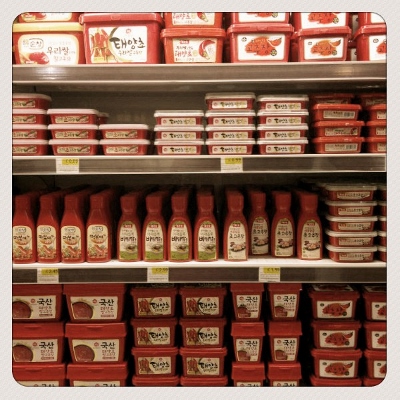Because I grew up in the South, the only hot sauce that I had ever heard of was vinegary Tabasco and what most people outside of East Texas call “salsa.” My people were not the culinarily adventurous type, which meant that my only exposure to Asian food was bad Chinese buffets and frozen egg rolls.
But then came sriracha, everyone’s favorite hot sauce. As the spicy chili sauce got hotter and hotter—figuratively speaking—showing up on menus in every kind of restaurant ranging from fast food to fine dining, it quickly became ubiquitous. You can find a bottle of sriracha on the condiment bar at Chipotle, of all places, which is a real testament to the sauce’s popularity.
Now, there’s a new spicy Asian sauce that is poised to become equally common. Gochujang, a spicy fermented chili paste, has long been a household staple in Korea, found in the elaborate assortment of condiments that accompany most Korean dishes, applied liberally to bibimbap and rice dishes and just about everything else that is eaten in Korea.
Gochujang is quickly taking over menus across the country, and it deserves a space in every serious home cook’s pantry. Its complex, earthy flavor and pungent dose of kick is exactly the kind of excitement that you should be adding to your home-cooked dishes.
Traditionally, gochujang was made in Korea by fermenting glutinous rice, red chili, soybeans, and salt in big clay pots. The pots, similar to those used in the making of kimchi, were left out on raised stone platforms for entire years to ferment. The process has since been modernized, but gochujang is still fermented for months to create its thick texture and rich and complex flavor profile.
Once fermented, the gochujang resembles tomato paste in color and texture, and has a similar earthy sweetness punctuated by a bite of lingering heat from the red chiles. Gochujang is similar to sriracha in taste, but there are some key differences. Garlic is a major component in the making of sriracha, and you won’t find that same flavor in gochujang. What gochujang offers, though, is a big dose of umami that sriracha just doesn’t have. The fermentation of the glutamates in red chiles produces an almost meaty flavor in the background, which is compelling considering that most productions of gochujang are completely vegan.
Much like you would use miso or anchovy paste to boost the umami flavor in a dish, gochujang can be substituted for sriracha when your flavors are falling a bit flat, even in unexpected applications. Mixed into an already-spicy pomodoro sauce or tomato-based tortilla soup broth, gochujang does an excellent job of tying competing flavors together and providing a nice dose of background heat. The kind that leaves your mouth burning for a while after eating—in the good way.
Once you’ve tried it, you’ll soon find that you’re using it in place of just about every other hot sauce you employ in your kitchen. Gochujang is great mixed into a marinade for beef, used as a spicy and buttery sauce for chicken wings, or just squirted onto a plate of perfectly scrambled eggs. Mixing a healthy glob of gochujang into the mayonnaise that you spread on those sandwiches that you eat every day will seriously elevate your brown-bag game. Even instant ramen and frozen rice bowls can be turned into a respectable meal with a dab of gochujang for flavor.
There are also occasions where gochujang could save your ass in the kitchen. For a ridiculously good last-minute party dip, mix a little gochujang with cream cheese, chopped scallions, and sesame oil. Top with a sprinkle of black sesame seeds, and serve with crackers the next time your weird neighbors show up uninvited at the door. If you overcook the chicken, just make sure there’s plenty of gochujang on the table and no one will ever notice.
You can now find gochujang in most specialty grocery stores, and it has been available in Asian markets in the United States for decades. Chung Jung One is a relatively popular brand in supermarkets, and is a pretty good entry point for those who don’t frequent Asian markets. A 7.5 ounce bottle will run you less than $5. Gochujang is often sold in plastic tubs, but is now offered in squeeze bottles for convenience.
You probably already have an array of chili pastes and pepper sauces in your refrigerator, but gochujang is worth making room for. Its versatility and rich flavor are perfect in just about any dish, which means that like sriracha, gochujang won’t just be a culinary trend. We’ll be seeing this hot sauce stick around for a long time to come.

Flickr/Tim Walker
Amy McCarthy is a writer and editor living in Dallas, Texas. She enjoys lipstick, cooking, and fighting with celebrities on Twitter.